Strategies for Effective Negotiation
VerifiedAdded on 2019/09/30
|8
|2514
|59
Report
AI Summary
Here is a short summary of the provided content in one paragraph: The objectives of negotiation are to achieve an agreement that meets one's needs, considering ideal, acceptable, and worst-case scenarios. Effective negotiation requires providing necessary information to the other party, assessing concessions and costs, creating a strategy, planning the negotiation, and maintaining a positive and rational approach. Emotions should be managed, and displays of emotions should be avoided. Prior preparation is essential for successful negotiations. In particular, buyer positioning tactics and mannerisms need to be understood and dealt with accordingly. Accurate recording of negotiations and decisions is crucial for future reference and risk management. Finally, patience, honesty, flexibility, professionalism, and tact are essential qualities for effective negotiation.
Contribute Materials
Your contribution can guide someone’s learning journey. Share your
documents today.
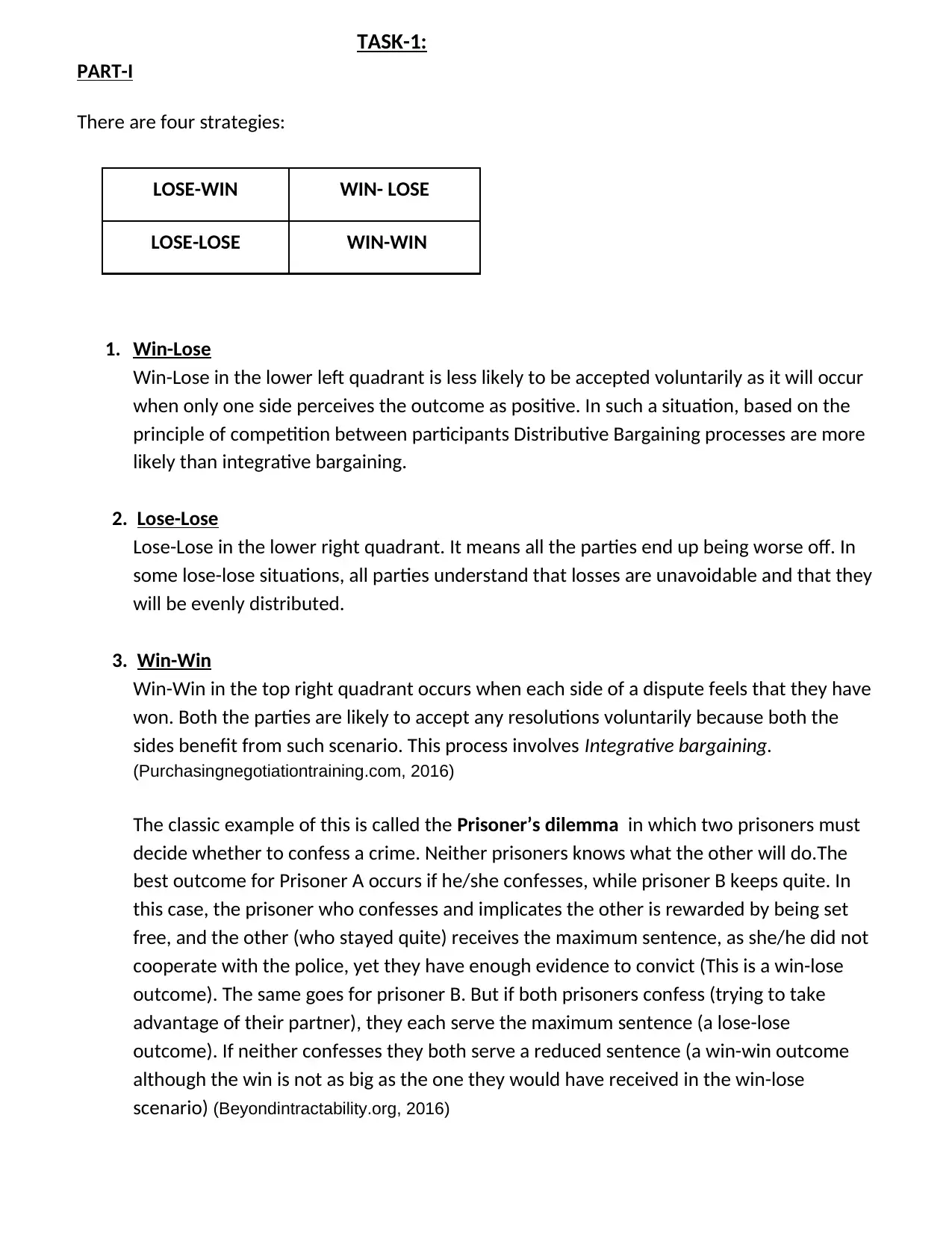
TASK-1:
PART-I
There are four strategies:
1. Win-Lose
Win-Lose in the lower left quadrant is less likely to be accepted voluntarily as it will occur
when only one side perceives the outcome as positive. In such a situation, based on the
principle of competition between participants Distributive Bargaining processes are more
likely than integrative bargaining.
2. Lose-Lose
Lose-Lose in the lower right quadrant. It means all the parties end up being worse off. In
some lose-lose situations, all parties understand that losses are unavoidable and that they
will be evenly distributed.
3. Win-Win
Win-Win in the top right quadrant occurs when each side of a dispute feels that they have
won. Both the parties are likely to accept any resolutions voluntarily because both the
sides benefit from such scenario. This process involves Integrative bargaining.
(Purchasingnegotiationtraining.com, 2016)
The classic example of this is called the Prisoner’s dilemma in which two prisoners must
decide whether to confess a crime. Neither prisoners knows what the other will do.The
best outcome for Prisoner A occurs if he/she confesses, while prisoner B keeps quite. In
this case, the prisoner who confesses and implicates the other is rewarded by being set
free, and the other (who stayed quite) receives the maximum sentence, as she/he did not
cooperate with the police, yet they have enough evidence to convict (This is a win-lose
outcome). The same goes for prisoner B. But if both prisoners confess (trying to take
advantage of their partner), they each serve the maximum sentence (a lose-lose
outcome). If neither confesses they both serve a reduced sentence (a win-win outcome
although the win is not as big as the one they would have received in the win-lose
scenario) (Beyondintractability.org, 2016)
WIN- LOSELOSE-WIN
WIN-WINLOSE-LOSE
PART-I
There are four strategies:
1. Win-Lose
Win-Lose in the lower left quadrant is less likely to be accepted voluntarily as it will occur
when only one side perceives the outcome as positive. In such a situation, based on the
principle of competition between participants Distributive Bargaining processes are more
likely than integrative bargaining.
2. Lose-Lose
Lose-Lose in the lower right quadrant. It means all the parties end up being worse off. In
some lose-lose situations, all parties understand that losses are unavoidable and that they
will be evenly distributed.
3. Win-Win
Win-Win in the top right quadrant occurs when each side of a dispute feels that they have
won. Both the parties are likely to accept any resolutions voluntarily because both the
sides benefit from such scenario. This process involves Integrative bargaining.
(Purchasingnegotiationtraining.com, 2016)
The classic example of this is called the Prisoner’s dilemma in which two prisoners must
decide whether to confess a crime. Neither prisoners knows what the other will do.The
best outcome for Prisoner A occurs if he/she confesses, while prisoner B keeps quite. In
this case, the prisoner who confesses and implicates the other is rewarded by being set
free, and the other (who stayed quite) receives the maximum sentence, as she/he did not
cooperate with the police, yet they have enough evidence to convict (This is a win-lose
outcome). The same goes for prisoner B. But if both prisoners confess (trying to take
advantage of their partner), they each serve the maximum sentence (a lose-lose
outcome). If neither confesses they both serve a reduced sentence (a win-win outcome
although the win is not as big as the one they would have received in the win-lose
scenario) (Beyondintractability.org, 2016)
WIN- LOSELOSE-WIN
WIN-WINLOSE-LOSE
Secure Best Marks with AI Grader
Need help grading? Try our AI Grader for instant feedback on your assignments.

Part-II
Win –Win behaviour gives a contrast reaction than the win loose behaviour which can be
summoned as being cooperative to non-cooperative
Body language, emotions and behavior which might be exhibited can be explained with the help
of an example:
A-Being Non cooperative B-Being cooperative
Behaviour
More of me means less of you.
Being aggressively competitive.
Prefers to dominate on others
Favors bluff.
Attitude
My interest is more important
than preserving the
relationship with others.
You have to be cruel to get kind
in the business.
Looking at own interest first
and leave others.
Behaviour
More of me means more of you
Being assertively competitive
Prefers mutual coordination.
Doesn’t bluff.
Attitude
Good relationship is more
important than taking advantage
of others weakness.
A margin deal is better than no
deal.
Negotiators should not open
their feelings and intentions
Part-III
While conducting a one time negotiation we do not expect to interact with the party again in
the future so we might consider taking the distributive negotiation or bargaining approach to
achieve as much gain as we can and if we consider to interact in future over long term then we
need to focus, adjust and think along the lines as it might receive a value of higher benefit from
the prospective buyer
By gaining an understanding of the consequences of winning or losing for both yourself and your
opponent will help us plan in a better way our strategy for the negotiation. Moreover this will
allow us to make more effective decisions and get ourselves prepare for possible obstacles,
challenges or opportunities that could in future.
Part-IV
The ‘win-win’ negotiation is often seen as most desirable outcome as it depicts that the
negotiating parties have reached an agreement which cannot be improved upon through further
discussion and negotiations.
Some of the circumstances can be explained with the help of example:
Skilled negotiators usually manage expectations prior to and during a negotiation. Some do this
instinctively. In order to avoid increasing opponents’ expectations they make less concessions .
Ensure that the opponent perceives the outcome as being beneficial by being modest about the
gains from a deal.
Win –Win behaviour gives a contrast reaction than the win loose behaviour which can be
summoned as being cooperative to non-cooperative
Body language, emotions and behavior which might be exhibited can be explained with the help
of an example:
A-Being Non cooperative B-Being cooperative
Behaviour
More of me means less of you.
Being aggressively competitive.
Prefers to dominate on others
Favors bluff.
Attitude
My interest is more important
than preserving the
relationship with others.
You have to be cruel to get kind
in the business.
Looking at own interest first
and leave others.
Behaviour
More of me means more of you
Being assertively competitive
Prefers mutual coordination.
Doesn’t bluff.
Attitude
Good relationship is more
important than taking advantage
of others weakness.
A margin deal is better than no
deal.
Negotiators should not open
their feelings and intentions
Part-III
While conducting a one time negotiation we do not expect to interact with the party again in
the future so we might consider taking the distributive negotiation or bargaining approach to
achieve as much gain as we can and if we consider to interact in future over long term then we
need to focus, adjust and think along the lines as it might receive a value of higher benefit from
the prospective buyer
By gaining an understanding of the consequences of winning or losing for both yourself and your
opponent will help us plan in a better way our strategy for the negotiation. Moreover this will
allow us to make more effective decisions and get ourselves prepare for possible obstacles,
challenges or opportunities that could in future.
Part-IV
The ‘win-win’ negotiation is often seen as most desirable outcome as it depicts that the
negotiating parties have reached an agreement which cannot be improved upon through further
discussion and negotiations.
Some of the circumstances can be explained with the help of example:
Skilled negotiators usually manage expectations prior to and during a negotiation. Some do this
instinctively. In order to avoid increasing opponents’ expectations they make less concessions .
Ensure that the opponent perceives the outcome as being beneficial by being modest about the
gains from a deal.
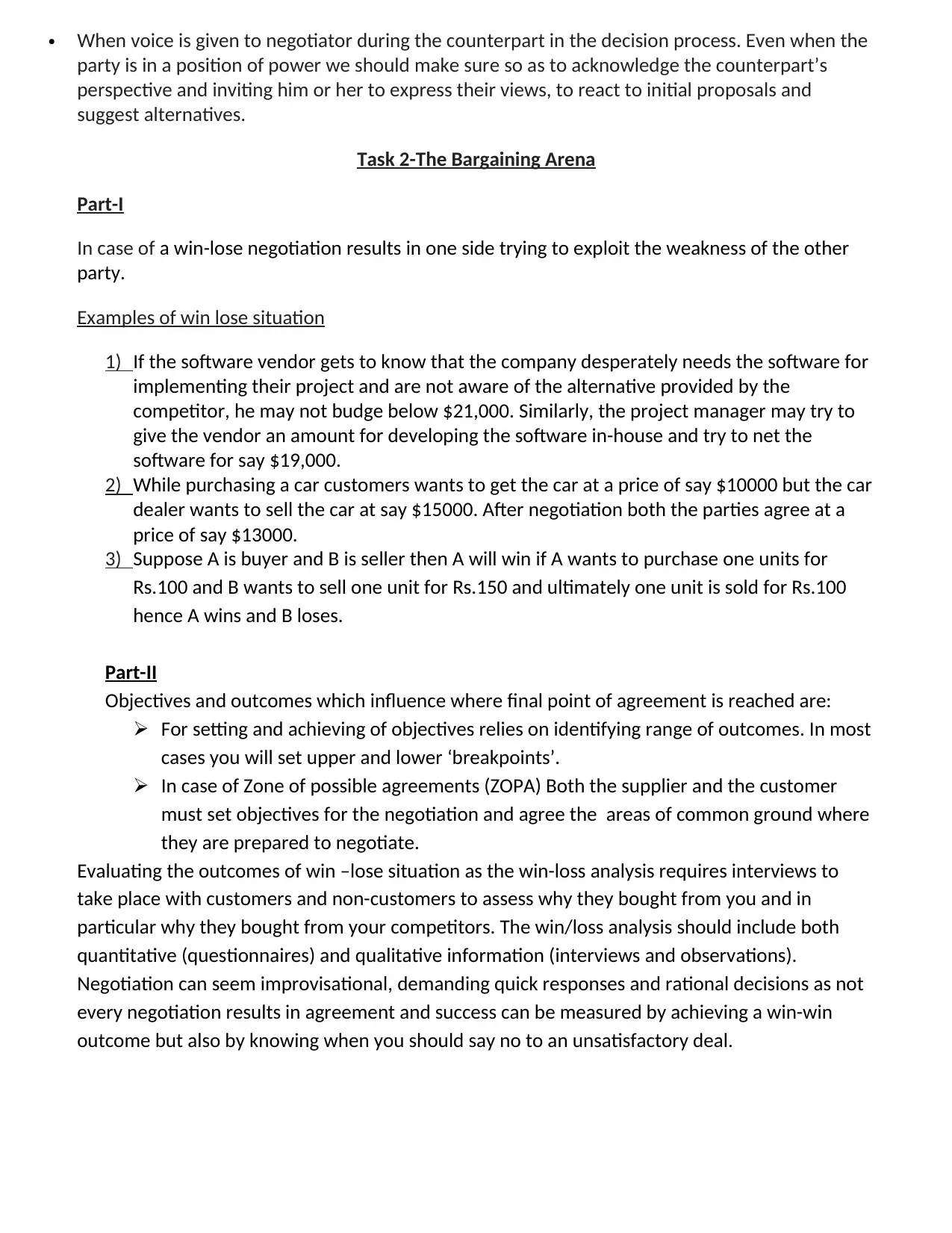
When voice is given to negotiator during the counterpart in the decision process. Even when the
party is in a position of power we should make sure so as to acknowledge the counterpart’s
perspective and inviting him or her to express their views, to react to initial proposals and
suggest alternatives.
Task 2-The Bargaining Arena
Part-I
In case of a win-lose negotiation results in one side trying to exploit the weakness of the other
party.
Examples of win lose situation
1) If the software vendor gets to know that the company desperately needs the software for
implementing their project and are not aware of the alternative provided by the
competitor, he may not budge below $21,000. Similarly, the project manager may try to
give the vendor an amount for developing the software in-house and try to net the
software for say $19,000.
2) While purchasing a car customers wants to get the car at a price of say $10000 but the car
dealer wants to sell the car at say $15000. After negotiation both the parties agree at a
price of say $13000.
3) Suppose A is buyer and B is seller then A will win if A wants to purchase one units for
Rs.100 and B wants to sell one unit for Rs.150 and ultimately one unit is sold for Rs.100
hence A wins and B loses.
Part-II
Objectives and outcomes which influence where final point of agreement is reached are:
For setting and achieving of objectives relies on identifying range of outcomes. In most
cases you will set upper and lower ‘breakpoints’.
In case of Zone of possible agreements (ZOPA) Both the supplier and the customer
must set objectives for the negotiation and agree the areas of common ground where
they are prepared to negotiate.
Evaluating the outcomes of win –lose situation as the win-loss analysis requires interviews to
take place with customers and non-customers to assess why they bought from you and in
particular why they bought from your competitors. The win/loss analysis should include both
quantitative (questionnaires) and qualitative information (interviews and observations).
Negotiation can seem improvisational, demanding quick responses and rational decisions as not
every negotiation results in agreement and success can be measured by achieving a win-win
outcome but also by knowing when you should say no to an unsatisfactory deal.
party is in a position of power we should make sure so as to acknowledge the counterpart’s
perspective and inviting him or her to express their views, to react to initial proposals and
suggest alternatives.
Task 2-The Bargaining Arena
Part-I
In case of a win-lose negotiation results in one side trying to exploit the weakness of the other
party.
Examples of win lose situation
1) If the software vendor gets to know that the company desperately needs the software for
implementing their project and are not aware of the alternative provided by the
competitor, he may not budge below $21,000. Similarly, the project manager may try to
give the vendor an amount for developing the software in-house and try to net the
software for say $19,000.
2) While purchasing a car customers wants to get the car at a price of say $10000 but the car
dealer wants to sell the car at say $15000. After negotiation both the parties agree at a
price of say $13000.
3) Suppose A is buyer and B is seller then A will win if A wants to purchase one units for
Rs.100 and B wants to sell one unit for Rs.150 and ultimately one unit is sold for Rs.100
hence A wins and B loses.
Part-II
Objectives and outcomes which influence where final point of agreement is reached are:
For setting and achieving of objectives relies on identifying range of outcomes. In most
cases you will set upper and lower ‘breakpoints’.
In case of Zone of possible agreements (ZOPA) Both the supplier and the customer
must set objectives for the negotiation and agree the areas of common ground where
they are prepared to negotiate.
Evaluating the outcomes of win –lose situation as the win-loss analysis requires interviews to
take place with customers and non-customers to assess why they bought from you and in
particular why they bought from your competitors. The win/loss analysis should include both
quantitative (questionnaires) and qualitative information (interviews and observations).
Negotiation can seem improvisational, demanding quick responses and rational decisions as not
every negotiation results in agreement and success can be measured by achieving a win-win
outcome but also by knowing when you should say no to an unsatisfactory deal.

TASK-3- VARIABLES
PART- I
The variables that an organization can bring into deal making are:
1. CUSTOMER SERVICES
It is the ability of an organization to help customers and sort out issues as and when they arise.
Organizations must connect with the individuals/customers to understand their needs.
2. NEW PERSPECTIVES AND IDEAS
Organizations must be able to bring something new on the table.
3. PROVIDE VALUE THAT IS SUPERIOR TO OTHER OPTIONS
Organizations should prove that buying from you is the right business decision as it is superior to
others.
4. EASE OF DOING THE BUSINESS
In this era of automated and mobile enabled world customers want websites which are easy to
navigate so that it becomes easier for them to contact an organization.
PART-II
The variables that customers can offer are:
1. TIMELY RECEIPT OF PAYMENT
Timely receipt of payment from customers for goods/services sold by an organization can be
regarded as value addition by the customers.
2. GOOD REPUTATION IN THE BUSINESS
If a customer has a good reputation in the business then the organization can sell the goods on
credit otherwise, the organization engages in cash sales. In other words, the creditworthiness of
a customer is important to the organization.
PART-III
The variables that are really important are:
Customers Services.
New ideas.
PART-IV
PART- I
The variables that an organization can bring into deal making are:
1. CUSTOMER SERVICES
It is the ability of an organization to help customers and sort out issues as and when they arise.
Organizations must connect with the individuals/customers to understand their needs.
2. NEW PERSPECTIVES AND IDEAS
Organizations must be able to bring something new on the table.
3. PROVIDE VALUE THAT IS SUPERIOR TO OTHER OPTIONS
Organizations should prove that buying from you is the right business decision as it is superior to
others.
4. EASE OF DOING THE BUSINESS
In this era of automated and mobile enabled world customers want websites which are easy to
navigate so that it becomes easier for them to contact an organization.
PART-II
The variables that customers can offer are:
1. TIMELY RECEIPT OF PAYMENT
Timely receipt of payment from customers for goods/services sold by an organization can be
regarded as value addition by the customers.
2. GOOD REPUTATION IN THE BUSINESS
If a customer has a good reputation in the business then the organization can sell the goods on
credit otherwise, the organization engages in cash sales. In other words, the creditworthiness of
a customer is important to the organization.
PART-III
The variables that are really important are:
Customers Services.
New ideas.
PART-IV
Secure Best Marks with AI Grader
Need help grading? Try our AI Grader for instant feedback on your assignments.
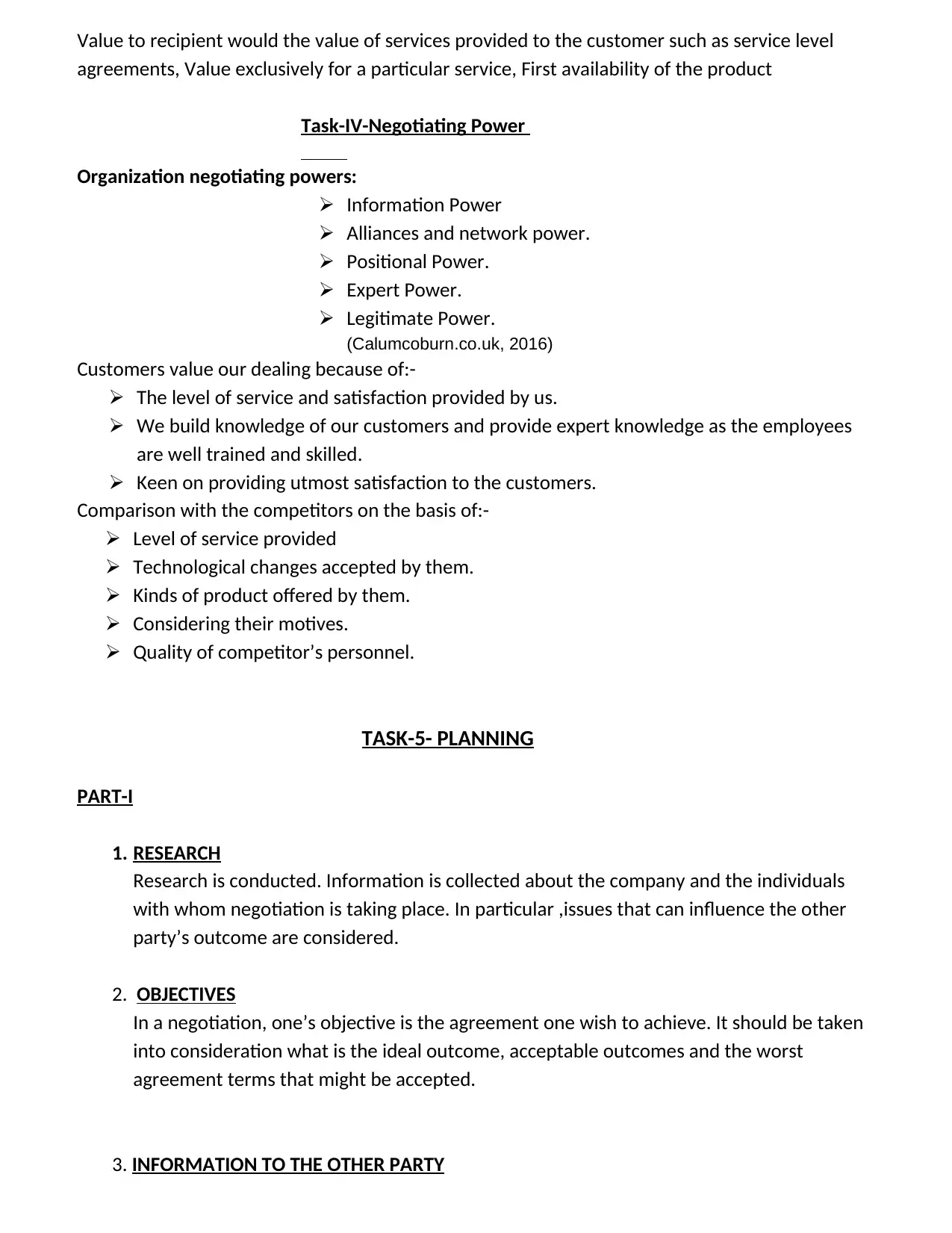
Value to recipient would the value of services provided to the customer such as service level
agreements, Value exclusively for a particular service, First availability of the product
Task-IV-Negotiating Power
Organization negotiating powers:
Information Power
Alliances and network power.
Positional Power.
Expert Power.
Legitimate Power.
(Calumcoburn.co.uk, 2016)
Customers value our dealing because of:-
The level of service and satisfaction provided by us.
We build knowledge of our customers and provide expert knowledge as the employees
are well trained and skilled.
Keen on providing utmost satisfaction to the customers.
Comparison with the competitors on the basis of:-
Level of service provided
Technological changes accepted by them.
Kinds of product offered by them.
Considering their motives.
Quality of competitor’s personnel.
TASK-5- PLANNING
PART-I
1. RESEARCH
Research is conducted. Information is collected about the company and the individuals
with whom negotiation is taking place. In particular ,issues that can influence the other
party’s outcome are considered.
2. OBJECTIVES
In a negotiation, one’s objective is the agreement one wish to achieve. It should be taken
into consideration what is the ideal outcome, acceptable outcomes and the worst
agreement terms that might be accepted.
3. INFORMATION TO THE OTHER PARTY
agreements, Value exclusively for a particular service, First availability of the product
Task-IV-Negotiating Power
Organization negotiating powers:
Information Power
Alliances and network power.
Positional Power.
Expert Power.
Legitimate Power.
(Calumcoburn.co.uk, 2016)
Customers value our dealing because of:-
The level of service and satisfaction provided by us.
We build knowledge of our customers and provide expert knowledge as the employees
are well trained and skilled.
Keen on providing utmost satisfaction to the customers.
Comparison with the competitors on the basis of:-
Level of service provided
Technological changes accepted by them.
Kinds of product offered by them.
Considering their motives.
Quality of competitor’s personnel.
TASK-5- PLANNING
PART-I
1. RESEARCH
Research is conducted. Information is collected about the company and the individuals
with whom negotiation is taking place. In particular ,issues that can influence the other
party’s outcome are considered.
2. OBJECTIVES
In a negotiation, one’s objective is the agreement one wish to achieve. It should be taken
into consideration what is the ideal outcome, acceptable outcomes and the worst
agreement terms that might be accepted.
3. INFORMATION TO THE OTHER PARTY
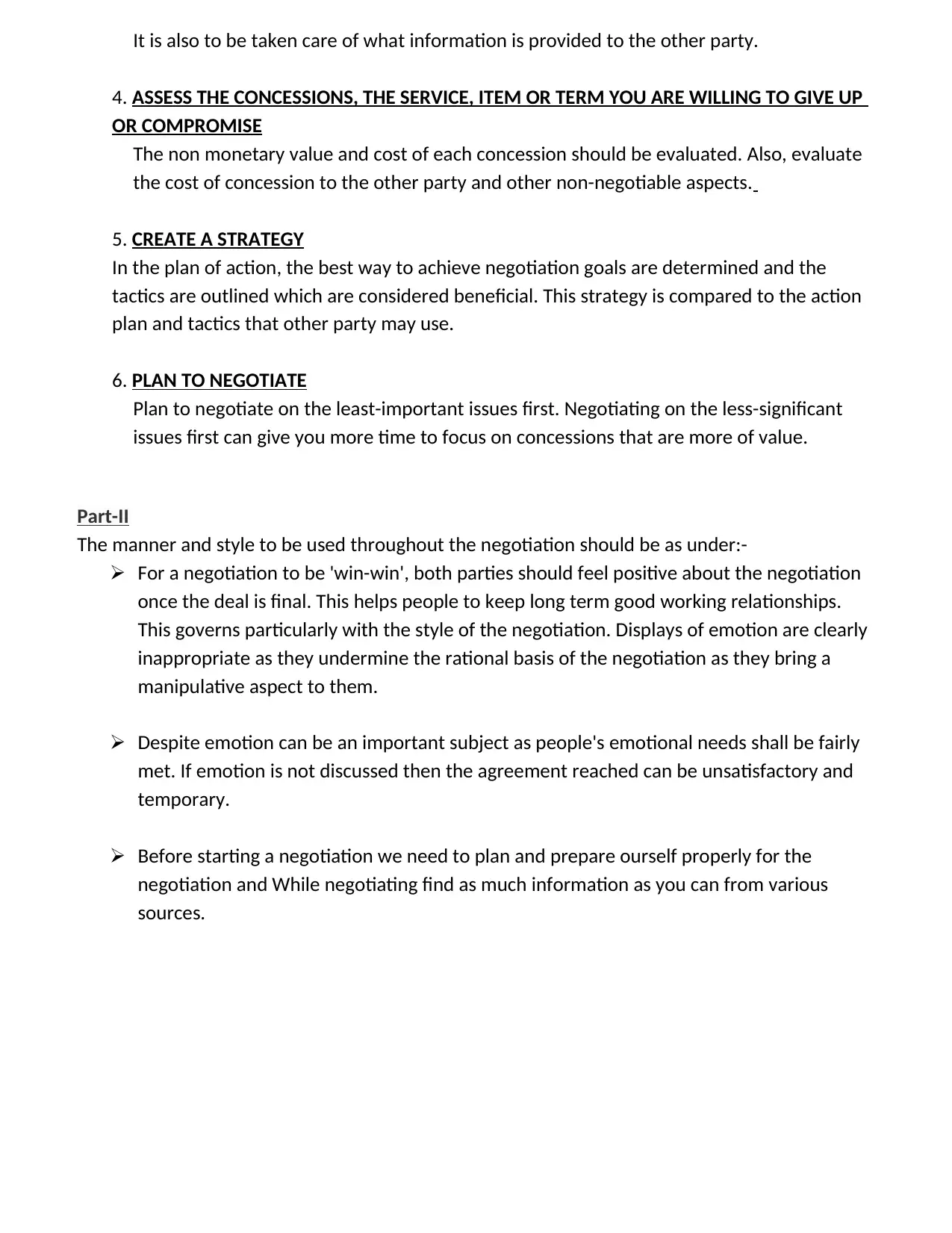
It is also to be taken care of what information is provided to the other party.
4. ASSESS THE CONCESSIONS, THE SERVICE, ITEM OR TERM YOU ARE WILLING TO GIVE UP
OR COMPROMISE
The non monetary value and cost of each concession should be evaluated. Also, evaluate
the cost of concession to the other party and other non-negotiable aspects.
5. CREATE A STRATEGY
In the plan of action, the best way to achieve negotiation goals are determined and the
tactics are outlined which are considered beneficial. This strategy is compared to the action
plan and tactics that other party may use.
6. PLAN TO NEGOTIATE
Plan to negotiate on the least-important issues first. Negotiating on the less-significant
issues first can give you more time to focus on concessions that are more of value.
Part-II
The manner and style to be used throughout the negotiation should be as under:-
For a negotiation to be 'win-win', both parties should feel positive about the negotiation
once the deal is final. This helps people to keep long term good working relationships.
This governs particularly with the style of the negotiation. Displays of emotion are clearly
inappropriate as they undermine the rational basis of the negotiation as they bring a
manipulative aspect to them.
Despite emotion can be an important subject as people's emotional needs shall be fairly
met. If emotion is not discussed then the agreement reached can be unsatisfactory and
temporary.
Before starting a negotiation we need to plan and prepare ourself properly for the
negotiation and While negotiating find as much information as you can from various
sources.
4. ASSESS THE CONCESSIONS, THE SERVICE, ITEM OR TERM YOU ARE WILLING TO GIVE UP
OR COMPROMISE
The non monetary value and cost of each concession should be evaluated. Also, evaluate
the cost of concession to the other party and other non-negotiable aspects.
5. CREATE A STRATEGY
In the plan of action, the best way to achieve negotiation goals are determined and the
tactics are outlined which are considered beneficial. This strategy is compared to the action
plan and tactics that other party may use.
6. PLAN TO NEGOTIATE
Plan to negotiate on the least-important issues first. Negotiating on the less-significant
issues first can give you more time to focus on concessions that are more of value.
Part-II
The manner and style to be used throughout the negotiation should be as under:-
For a negotiation to be 'win-win', both parties should feel positive about the negotiation
once the deal is final. This helps people to keep long term good working relationships.
This governs particularly with the style of the negotiation. Displays of emotion are clearly
inappropriate as they undermine the rational basis of the negotiation as they bring a
manipulative aspect to them.
Despite emotion can be an important subject as people's emotional needs shall be fairly
met. If emotion is not discussed then the agreement reached can be unsatisfactory and
temporary.
Before starting a negotiation we need to plan and prepare ourself properly for the
negotiation and While negotiating find as much information as you can from various
sources.
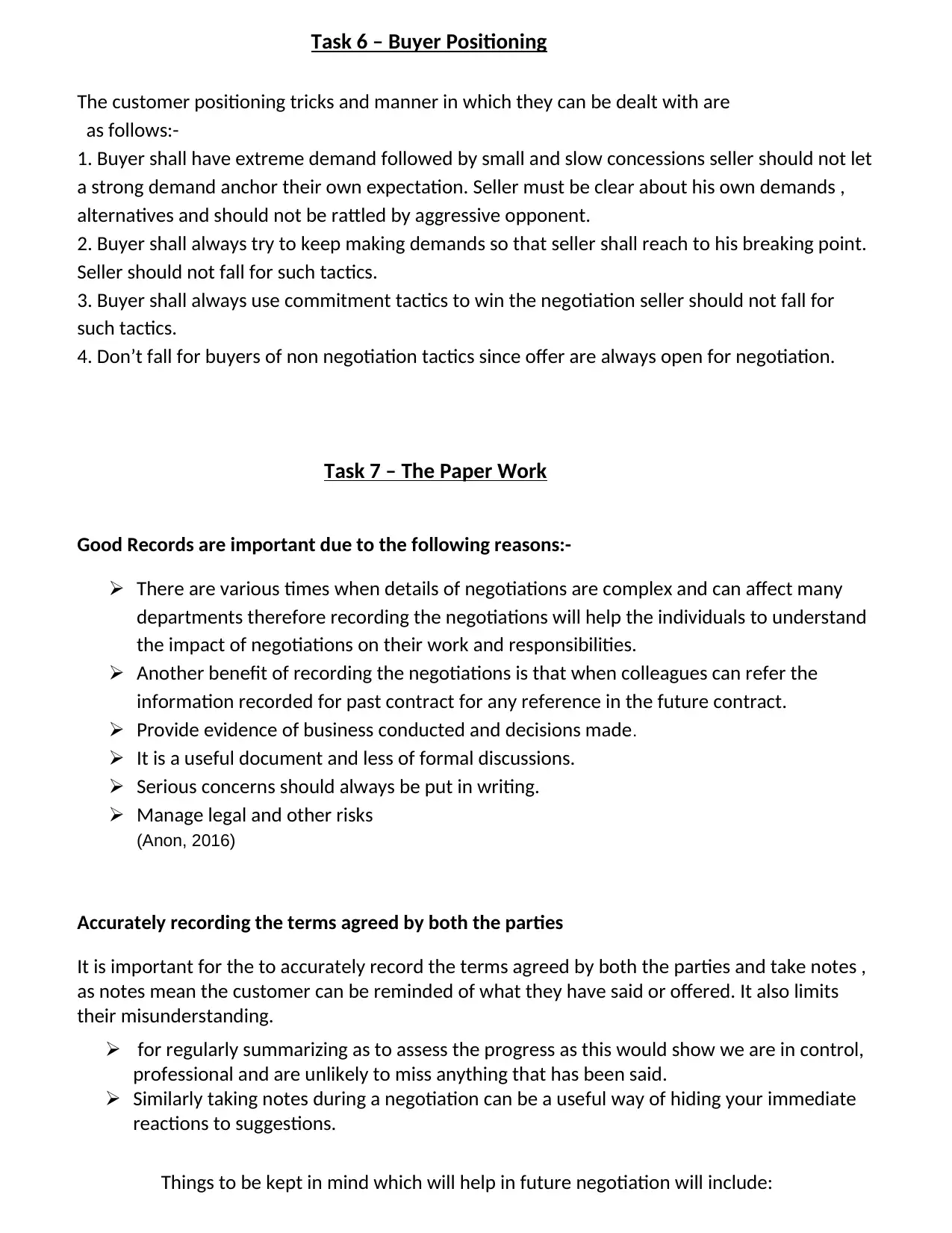
Task 6 – Buyer Positioning
The customer positioning tricks and manner in which they can be dealt with are
as follows:-
1. Buyer shall have extreme demand followed by small and slow concessions seller should not let
a strong demand anchor their own expectation. Seller must be clear about his own demands ,
alternatives and should not be rattled by aggressive opponent.
2. Buyer shall always try to keep making demands so that seller shall reach to his breaking point.
Seller should not fall for such tactics.
3. Buyer shall always use commitment tactics to win the negotiation seller should not fall for
such tactics.
4. Don’t fall for buyers of non negotiation tactics since offer are always open for negotiation.
Task 7 – The Paper Work
Good Records are important due to the following reasons:-
There are various times when details of negotiations are complex and can affect many
departments therefore recording the negotiations will help the individuals to understand
the impact of negotiations on their work and responsibilities.
Another benefit of recording the negotiations is that when colleagues can refer the
information recorded for past contract for any reference in the future contract.
Provide evidence of business conducted and decisions made.
It is a useful document and less of formal discussions.
Serious concerns should always be put in writing.
Manage legal and other risks
(Anon, 2016)
Accurately recording the terms agreed by both the parties
It is important for the to accurately record the terms agreed by both the parties and take notes ,
as notes mean the customer can be reminded of what they have said or offered. It also limits
their misunderstanding.
for regularly summarizing as to assess the progress as this would show we are in control,
professional and are unlikely to miss anything that has been said.
Similarly taking notes during a negotiation can be a useful way of hiding your immediate
reactions to suggestions.
Things to be kept in mind which will help in future negotiation will include:
The customer positioning tricks and manner in which they can be dealt with are
as follows:-
1. Buyer shall have extreme demand followed by small and slow concessions seller should not let
a strong demand anchor their own expectation. Seller must be clear about his own demands ,
alternatives and should not be rattled by aggressive opponent.
2. Buyer shall always try to keep making demands so that seller shall reach to his breaking point.
Seller should not fall for such tactics.
3. Buyer shall always use commitment tactics to win the negotiation seller should not fall for
such tactics.
4. Don’t fall for buyers of non negotiation tactics since offer are always open for negotiation.
Task 7 – The Paper Work
Good Records are important due to the following reasons:-
There are various times when details of negotiations are complex and can affect many
departments therefore recording the negotiations will help the individuals to understand
the impact of negotiations on their work and responsibilities.
Another benefit of recording the negotiations is that when colleagues can refer the
information recorded for past contract for any reference in the future contract.
Provide evidence of business conducted and decisions made.
It is a useful document and less of formal discussions.
Serious concerns should always be put in writing.
Manage legal and other risks
(Anon, 2016)
Accurately recording the terms agreed by both the parties
It is important for the to accurately record the terms agreed by both the parties and take notes ,
as notes mean the customer can be reminded of what they have said or offered. It also limits
their misunderstanding.
for regularly summarizing as to assess the progress as this would show we are in control,
professional and are unlikely to miss anything that has been said.
Similarly taking notes during a negotiation can be a useful way of hiding your immediate
reactions to suggestions.
Things to be kept in mind which will help in future negotiation will include:
Paraphrase This Document
Need a fresh take? Get an instant paraphrase of this document with our AI Paraphraser

To be patient
To be honest.
To be one own self
To be sincere rather than being serious.
To be flexible and learn to compromise.
To be professional in the approach.
To be little tactful and diplomatic.
Previously the negotiation was not:
face to face so now the practices that to be followed for an effective and successful
negotiation is to have a ‘face-to-face’ negotiation and Try avoiding negotiating over the
phone or email as Negotiating in person helps us to understand the other person better
by watching his body language, facial expressions and other cues that can help you
negotiate better by knowing what the other person is thinking.
Tactful and diplomatic
Sellers were unprepared and were not confident enough.
Reference
1. Purchasingnegotiationtraining.com. (2016). What Does Win-Win Negotiation Mean? |
Purchasing and Negotiation Training. [online] Available at:
http://purchasingnegotiationtraining.com/negotiation/what-does-win-win-negotiation-
mean/ [Accessed 11 Dec. 2016].
2. Beyondintractability.org. (2016). Win-Win / Win-Lose / Lose-Lose Situations | Beyond
Intractability. [online] Available at: http://www.beyondintractability.org/essay/win-lose
[Accessed 11 Dec. 2016].
3. Calumcoburn.co.uk. (2016). Negotiation Power Article Power in Negotiations Negotiating
Power Relationship Power, London UK | Negotiation Training. [online] Available at:
http://www.calumcoburn.co.uk/articles/articles-powerone/ [Accessed 11 Dec. 2016].
4. Anon, (2016). [online] Available at:
http://www.adelaide.edu.au/legalandrisk/contracts/contracthandbook/Module_4.pdf
[Accessed 11 Dec. 2016].
To be honest.
To be one own self
To be sincere rather than being serious.
To be flexible and learn to compromise.
To be professional in the approach.
To be little tactful and diplomatic.
Previously the negotiation was not:
face to face so now the practices that to be followed for an effective and successful
negotiation is to have a ‘face-to-face’ negotiation and Try avoiding negotiating over the
phone or email as Negotiating in person helps us to understand the other person better
by watching his body language, facial expressions and other cues that can help you
negotiate better by knowing what the other person is thinking.
Tactful and diplomatic
Sellers were unprepared and were not confident enough.
Reference
1. Purchasingnegotiationtraining.com. (2016). What Does Win-Win Negotiation Mean? |
Purchasing and Negotiation Training. [online] Available at:
http://purchasingnegotiationtraining.com/negotiation/what-does-win-win-negotiation-
mean/ [Accessed 11 Dec. 2016].
2. Beyondintractability.org. (2016). Win-Win / Win-Lose / Lose-Lose Situations | Beyond
Intractability. [online] Available at: http://www.beyondintractability.org/essay/win-lose
[Accessed 11 Dec. 2016].
3. Calumcoburn.co.uk. (2016). Negotiation Power Article Power in Negotiations Negotiating
Power Relationship Power, London UK | Negotiation Training. [online] Available at:
http://www.calumcoburn.co.uk/articles/articles-powerone/ [Accessed 11 Dec. 2016].
4. Anon, (2016). [online] Available at:
http://www.adelaide.edu.au/legalandrisk/contracts/contracthandbook/Module_4.pdf
[Accessed 11 Dec. 2016].
1 out of 8
Related Documents
Your All-in-One AI-Powered Toolkit for Academic Success.
+13062052269
info@desklib.com
Available 24*7 on WhatsApp / Email
![[object Object]](/_next/static/media/star-bottom.7253800d.svg)
Unlock your academic potential
© 2024 | Zucol Services PVT LTD | All rights reserved.
